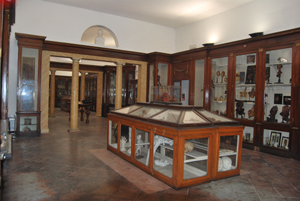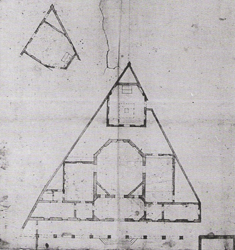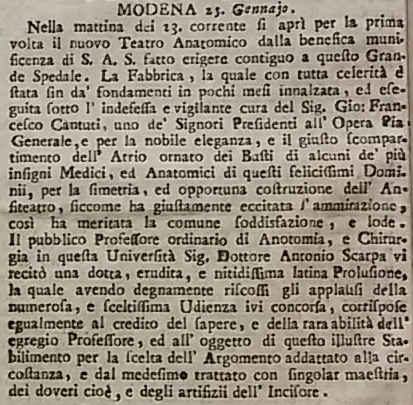

The Anatomical Museums of the University of Modena and Reggio Emilia were built starting from the second half of the XVIII century and are composed of several museums.
As we have already spoken about, Michele Rosa became interpreter of the difficulties faced by Scarpa during the Anatomy lessons in the small room on the ground floor of the Big Hospital. On the 30th December 1772, he proposed to build the Anatomical Theatre in the Rector Palace. At the beginning of February 1773, the duke Francesco III, who had provided in the University reform the construction of a new Theatre, answered that the proposal wasn’t adapt because of the narrow spaces and the he considered more suitable that the Theatre were planned in the big Hospital.
In 1773, the Opera Pia Congregation, after having carried out an inspection in the enclosure of the Sant’Agostino Hospital, confirmed the opportunity of choosing that place for the construction of an anatomical theatre, that, according with Scarpa professor, would have been built where the San Nicolò church was located.
Scarpa was charged from the president of Opera Pia Generale dei Poveri (General Religious Charity of Poor), Ippolito Bagnesi, to plan the structure of the Anatomical Theatre. Three plans were done:
- He decided in this way to ask the professor of surgical institutions of Padua University, Girolamo Vandelli from Modena, for the project of the Theatre realized in that University, fulfilled by Fabrizio Acquapendente (costed 364 lire).
- The second one was realized by the engineer Lodovico Bolognini, costed 360 lire.
- The third one was a plan of Lorenzo Toschi, costed 135 lire.

The third plan was the selected one, in the fact the less expensive. The San Nicolò Chapel was pulled down and built in the adjoining space again: it was the “universal depository not only of the deaths of the civic and military Hospitals but of the whole city”. The new building of the anatomical theatre consisted of a “room of anatomical theatre”, where were placed the laboratories namely “two rooms one for side of the room and small room, and four other rooms and entrance in the front vault porch” with nine arches, four of those are nowadays closed. In the entrance or atrium, over five doors facing on it (one of principal access to theatre and two of secondary access, two of access to side rooms), five busts of illustrious medicine professors of the Modena University were placed (realized by sculptor Sebastiano Pantanelli from Pesaro). Four busts still maintain the original position. The principal entrance of the anatomical theatre was in the block of the Sant’Agostino Hospital: a second access was in Piazza d’Armi at that time (nowadays Piazza Novi Sad).
The anatomical theatre was officially inaugurated on the 23rd of January 1775 with a very appreciated lesson in Latin language of Scarpa, even though the works weren’t finished.

The pavement of the theatre was still missing and was completed on the 10th of April 1775. It was a real and complete amphitheatre, with an extended ellipsis perpendicular to the atrium, but anyway less high and less narrow of that realized in Padua on plan of Acquapendente and with larger steps and furnished, at least in part, with benches: it could hold four hundred persons.
Starting from 1817, the duke Francesco IV decided to enlarge the spaces for the teaching of medical subjects and to enrich the surgical instrumentation.
He ordered that a new floor were erected over the Anatomical Theatre and the annex rooms, where an Anatomical Museum could be realized, in order to give an adequate location to the increasing anatomical preparations. The construction works, ended the year later up, caused a reduction of the Theatre on the northern side facing the porch.
The obstetrical collection, started from Scarpa for his lessons, had a significant increasing after the Restoration. Between 1880 and 1882, the Obstetrical Museum was restored from the director of the Institute at that time, professor Alessandro Cuzzi. The institute was located in the building annexed to Sant’Agostino Hospital, which corresponded to previous Home of God with the façade facing the current Ramazzini Street.
Nowadays, the obstetrical terracotta collection realized by Manfredini is showed in an adjacent room by the Anatomical Museum of XIX century.
The Anatomy chair was appointed to the professor Paolo Gaddi, that had collaborated with him as engraver and that restructured the rooms of the school and of the Anatomical Museum collecting in one building “a comfortable laboratory and a magnificent theatre, and a beautiful practice room, and a rich museum”.
In 1853, as written in the second part of the inscription placed on the principal entrance of the Anatomical Museum, thanks to the support of archduke Francesco V of Austria Este the Anatomical Museum was “reopened to the public in occasion of the Triennial exposition of fine arts”.
http://www.museianatomici.unimore.it/site/home/i-musei-anatomici/collezioni/museo-anatomico.html
Museo di Anatomia di Pavia
Il Museo, costituito alla fine del Settecento dagli anatomisti dell’Ateneo pavese e legato all’attività di scienziati quali Giacomo Rezia, Antonio Scarpa, Bartolomeo Panizza, Giovanni Zoja, costituisce un raro
esempio di “cristallizzazione” di un museo scientifico ottocentesco. Vi si conservano preparati prevalentemente naturali, articolati in diverse sezioni: Osteologia, Angiologia, Embriologia, Splancnologia, Estesiologia, Neurologia e Anatomia topografica.
Le comuni origini legano queste collezioni alla sezione di Medicina del Museo per la Storia dell’Università.
http://ppp.unipv.it/Museo/museo.htm
I video fanno parte del progetto per il corso di Comunicazione Digitale e Multimediale B, CdL in Comunicazione Interculturale e Multimediale, Università degli Studi di Pavia.
 https://www.youtube.com/channel/UCwu3OSAq1zzg6OQWVOc5iOg
https://www.youtube.com/channel/UCwu3OSAq1zzg6OQWVOc5iOg
 https://www.youtube.com/watch?v=_bXWAixelFM
https://www.youtube.com/watch?v=_bXWAixelFM
Aula Scarpa
Nel 1785 Leopoldo Pollack venne chiamato come sostituto di Piermarini per la realizzazione del nuovo Teatro Anatomico, che venne portato a compimento dopo aver preso contatto con il professore di anatomia Antonio Scarpa per conoscere le esigenze legate alla moderna impostazione dell'insegnamento e della ricerca. La realizzazione del progetto fu tempestiva e nel 1786 i lavori volgevano al termine.
L'aula semicircolare è da mettere in relazione ai modelli dei teatri antichi e all'esempio della realizzazione palladiana del Teatro Olimpico di Vicenza. Sul lato corto si aprono tre grandi finestre a tutto sesto, alle quali se ne aggiungono altre due, una per ogni parte, all'innesto del lato curvo; tra una finestra e l'altra sono dipinte delle urne cinerarie con geni alati di tipo funerario. Il motivo ad arco incominciato dalle finestre è moltiplicato dalle nicchie che si susseguono lungo tutto il lato curvo e contengono i busti marmorei di Scarpa, Panizza, Zoya, Sala, Pensa, Brambilla, Frank e Porta. La cavea, interamente realizzata in legno, è completata da balaustre a pilastrini; banchi e cattedra costituiscono due zone del tutto isolate con accessi separati. L'aula ebbe in un primo tempo il soffitto a cassettoni previsto da Pollack, come risulta anche dalle incisioni di Pietro Gilardoni del 1795, mentre l'attuale volta e la lanterna sono dovute al rifacimento del Marchesi, negli anni successivi alla restaurazione austriaca. Il soffitto ad ombrello innesta con naturalezza ogni spicchio sull'arco delle nicchie ed è dipinto da seguaci di Appiani con candelabre a grottesche pompeiane alternate a figure alate che reggono i ferri del chirurgo.
La decorazione ad affresco subì un primo restauro nel 1873 ad opera dei pittore pavese Carlo Sara, su incarico del rettore Francesco Cattaneo e un successivo restauro nel 1952. Il prospetto esterno è di grande rigore formale: il muro a bugnato è interrotto dalle tre finestre ad arco rette da piccole mensole; nel timpano, un oculo contiene un vaso cinerario. L'argomento fondamentale di un'aula di anatomia, cioè la morte, è chiaramente espresso dai cippi e dai vasi funerari, perché come il periodo neoclassico esigeva, la funzione di un luogo doveva essere manifestata anche dalla decorazione. L'aula venne in seguito dedicata ad Antonio Scarpa che si era proposto di fare della scuola anatomica pavese 'la prima in Europa'. Scarpa aveva aiutato Pollack con richieste e consigli durante la progettazione dell'aula e l'aveva lui stesso inaugurata il 31 ottobre 1785 con un solenne discorso
http://ppp.unipv.it/Museo/Pagine/Medicina/Medicina.htm